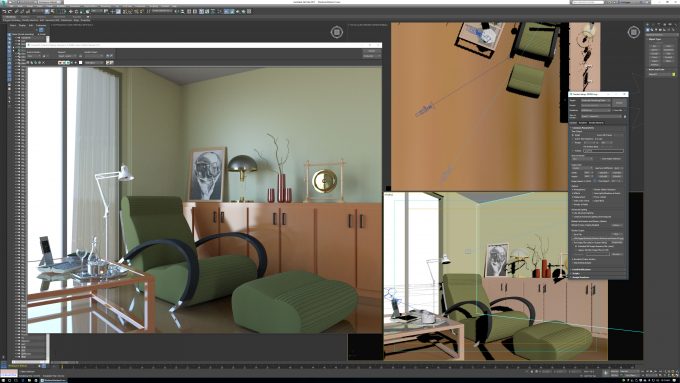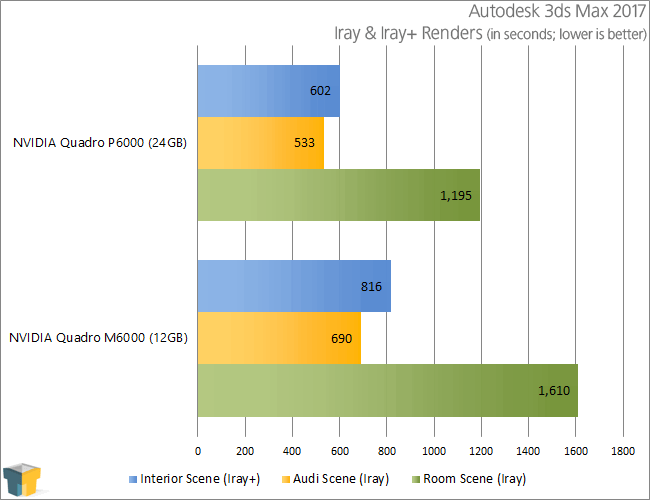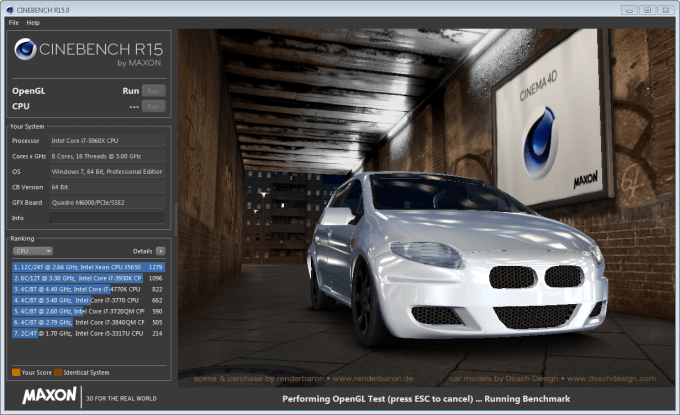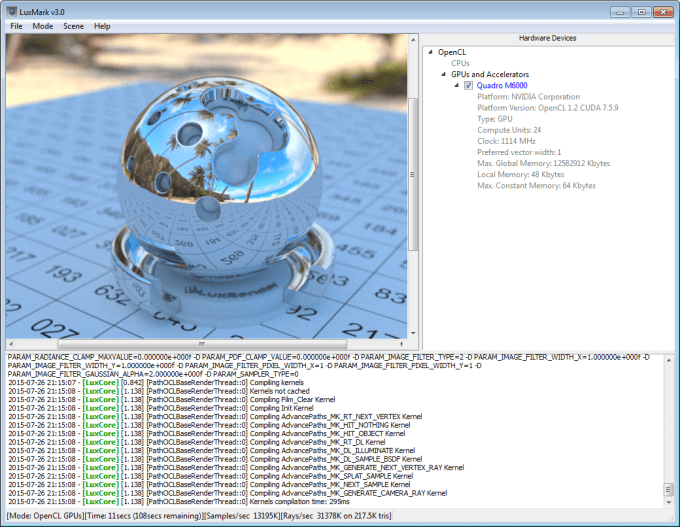- Qualcomm Launches Snapdragon 4 Gen 2 Mobile Platform
- AMD Launches Ryzen PRO 7000 Series Mobile & Desktop Platform
- Intel Launches Sleek Single-Slot Arc Pro A60 Workstation Graphics Card
- NVIDIA Announces Latest Ada Lovelace Additions: GeForce RTX 4060 Ti & RTX 4060
- Maxon Redshift With AMD Radeon GPU Rendering Support Now Available
NVIDIA’s Fastest Graphics Card Ever: A Look At The Quadro P6000

NVIDIA’s latest and greatest-ever workstation graphics card has arrived: Quadro P6000. This top-tier card is built around NVIDIA’s Pascal architecture, which is produced on a 16nm FinFET process. The card boasts an impressive 3,840 CUDA cores, and not to mention 24GB of super-fast GDDR5X. Let’s check it out.
Page 2 – Rendering: Autodesk 3ds Max, OctaneBench, LuxMark & Cinebench
Autodesk 3ds Max 2017
Our 3ds Max testing takes advantage of the suite’s latest version, 2017, and with it, we render three complex scenes: the interior of a room and an Audi automobile, both using Iray, and a second room interior, using Iray+.
Because 3ds Max 2017 doesn’t support NVIDIA’s Pascal architecture out-of-the-box, an official Autodesk plugin had to be installed, which conveniently came out just at the start of this month. If you’re using the latest version of 3ds Max and want Pascal support, hit up the Product Updates section in your Autodesk account dashboard. For Iray+, testing was done using the latest version of Lightwork’s plugin (1.30).
Despite having a huge performance advantage over the Quadro M6000, the P6000 doesn’t decimate that card’s performance quite like I expected. From a pure throughput perspective, the P6000 is about 71% faster than the M6000 (something later benchmarks will agree with), but it proves just about ~35% quicker here.
Given what I’ve seen from Iray scaling in the past, I’m simply led to believe that the plugins are not taking as much advantage of Pascal as they could. I’ll be revisiting Iray performance in a month or two, as I’ll be overhauling our test suite with updated tests (and test OS).
Synthetic: Cinebench & LuxMark
To compare our collection of workstation GPUs across other renderers, we rely on Cinebench and LuxMark. The latter is of particular interest as it renders using OpenCL. It also happens to be so good at what it does that we opt to use it for the sake of generating peak temperature and power information.
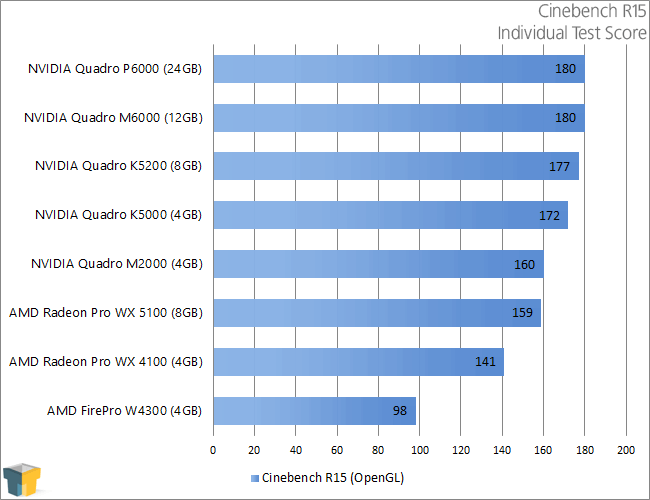
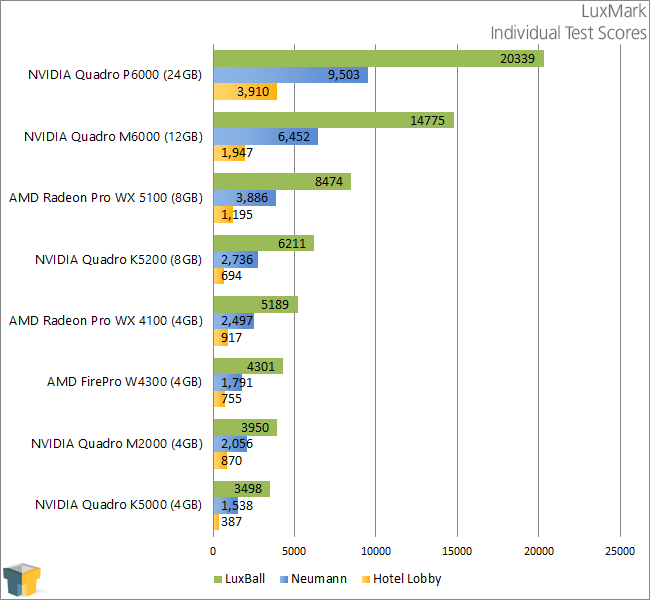
In the 3ds Max test at the top of the page, I mentioned that Pascal might not have perfect support for Iray right now, which is a bit of a theme with a brand-new architecture like this. As part of the Pascal launch, a new version of CUDA was also released, and the supporting software has yet to take full advantage of it so far. With that in mind, you can now probably take one guess why I didn’t include OctaneBench here!
In talking to OTOY, I was told that a new OctaneBench is en route, so once it drops, I’ll integrate it back into our testing.
Cinebench is one benchmark that’s growing long in the tooth, as both the M6000 and P6000 scored the same (likely a CPU bottleneck at this point), despite our gaming tests (coming up) showing great scaling between the two. In LuxMark, a test that exercises GPUs to their fullest, the P6000 dominates, becoming the first graphics card in our arsenal to ever breach 20,000 on the main LuxBall render.
The remaining LuxMark results highlight the fact that the P6000 can deliver even better results when the going gets tough. In the Hotel Lobby render, the most gruelling of the bunch, the P6000 actually manages to deliver a score more than twice that of the M6000. This is a great example of how much faster Pascal-based Quadros can be when they’re properly utilized.
Support our efforts! With ad revenue at an all-time low for written websites, we're relying more than ever on reader support to help us continue putting so much effort into this type of content. You can support us by becoming a Patron, or by using our Amazon shopping affiliate links listed through our articles. Thanks for your support!




